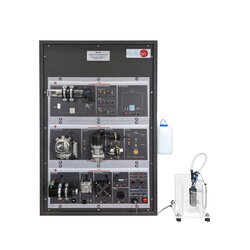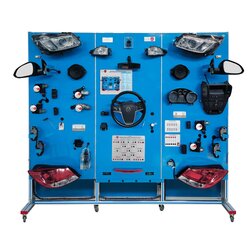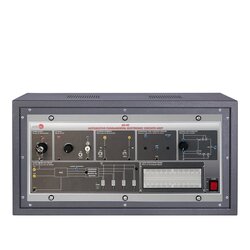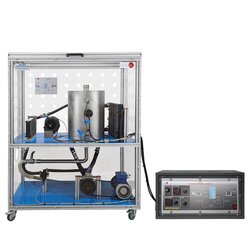Automotive Starting and Charging Systems unit (AV-SCS)
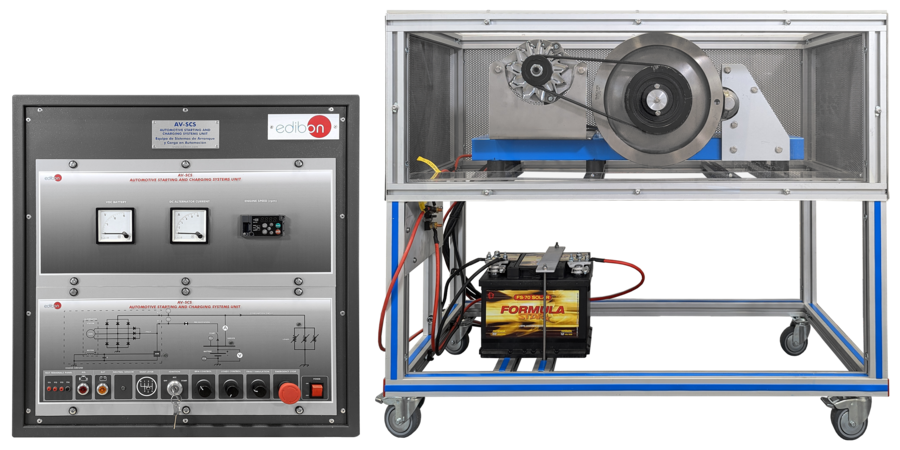


PL-201364
The Automotive Starting and Charging Systems Unit, “AV-SCS”, developed by EDIBON, offers a complete solution for theoretical and practical training in modern vehicle ignition and charging systems. This educational unit allows students to acquire the knowledge and skills needed to analyze and understand the function of key components such as the DC starter motor, alternator, solenoid relay, battery charging circuit, and ignition switch.
Students can explore how various circuits are powered based on the ignition key position, simulating the different system phases—from initial power-up and preheating to full engine start. The simulation is enhanced with an electric motor that replicates the function of a combustion engine and drives the alternator, enabling battery charging verification and circuit testing at critical points of the start-up process.
The “AV-SCS” includes an instrumentation panel with built-in fault simulation capabilities. This allows learners to practice diagnostics and troubleshooting procedures based on realistic scenarios. In addition, hands-on exercises are provided to deepen understanding of alternator voltage regulation and battery behavior during charge and discharge cycles.
Fault simulation features cover common failures in components like the battery, alternator, and motor, creating a safe environment for students to apply repair techniques. Designed to align with current and future industry requirements, the “AV-SCS” introduces students to advanced energy systems used in hybrid and electric vehicles.
The unit integrates a wide array of real automotive components and systems for comprehensive learning in energy management and electrical system diagnostics.
The “AV-SCS” unit includes the following components:
- DC starter motor.
- Starting solenoid.
- Park/neutral position switch.
- Run/start relay.
- Starting relay.
- Connectors.
- 12 VDC battery with accessible terminals (battery points).
- Fuse block.
- Ignition key for vehicle start (ignition switch).
- Protection fuse.
- Alternator.
- Electric motor for petrol engine simulation (EMT7/1K).
- Advanced AC Motor Speed Controller Module (N-VVCA).
- "AV-SCS”. Unit:
- DC starter motor.
- Nominal power: 0.5 kW (approx.)
- Nominal voltage: 12 VDC.
- Speed: 60 – 100 rpm.
- Starting solenoid: Nominal voltage: 12 VDC
- Run/start relay.
- Nominal voltage: 12 VDC.
- “NO” contact.
- “NC” contact.
- Park/neutral position switch.
- Nominal voltage: 12 VDC.
- “NO” contact.
- “NC” contact.
- Starting relay.
- Nominal voltage: 12 VDC.
- “NO” contact.
- “NC” contact.
- Connectors.
- 12 VDC battery with accessible terminals (battery points).
- Nominal voltage: 12 VDC.
- Capacity: 62 Ah.
- Accessible terminals.
- Terminals: positive/negative.
- Fuse block.
- Ignition key for starting the vehicle (ignition switch). Nominal voltage: 12 VDC.
- Protection fuse.
- Alternator.
- Nominal voltage: 12 VDC.
- Alternator charging current: 25 – 50 A.
- Electric motor for petrol engine simulation (EMT7/1K).
- Nominal power: 1100 W.
- Nominal voltage: 3 x 230 / 400 VAC Δ/Y.
- Frequency: 50 / 60 Hz.
- Number of poles: 2.
- Speed: 2730 rpm.
- Attached to the alternator by means of a belt and pulley system.
- Advanced AC Motor Speed Controller module (N-VVCA).
- Supply voltage: 230 VAC.
- Nominal power: 0.75 kW.
- PWM output voltage connections: Three-Phase: 230 VAC.
- Digital inputs control panel: five configurable digital inputs.
- Analog inputs control panel:
- 0 –10 V analog input for speed control.
- 4 – 20 mA analog input for speed control.
- 10 K potentiometer for speed control of induction motor.
- Two relay outputs for alarms configuration: two outputs NO / NC.
- Two 50 mA transistor outputs for alarm configuration.
- Setting and visualization display of the machine parameters.
- Cables and Accessories, for normal operation.
- Manuals: This unit is supplied with the following manuals: Required Services, Assembly and Installation, Starting-up, Safety, Maintenance and Practices manuals.
EXERCISES AND PRACTICAL POSSIBILITIES TO BE DONE WITH THE MAIN ITEMS
- Fundamentals of the electrical and electronic circuits of the vehicle involved in the starting system.
- Fundamentals of the DC electric motor. Study of the key parameters by taking measurements at its terminals.
- Fundamentals of the alternator. Study of the key parameters by taking measurements at its terminals.
- Fundamentals of the battery, operating principles, types, features and recharging systems.
- Fundamentals of the charging circuit, features, physical basis, and components of the alternator.
- Fundamentals of the charging circuit and maintenance of a vehicle battery.
- Identification of the starting system elements of a vehicle.
- Study of the park/neutral position switch. Study of its connection to the solenoid and how it is involved the starting circuit.
- Study of the starting solenoid relay. Study of its behavior in the starter motor coupling.
- Study of the ignition switch. Study of the various circuits involved in every key position.
- Study of the operation of the automotive starting system.
- Study of the drive circuit of the DC starter motor.
- Several other exercises can be done and designed by the user.
What is this?
These percentage scores are an average of 0 user reviews. To get more into detail, see each review and comments as per below
If you have used this product, support the community by submitting your review
